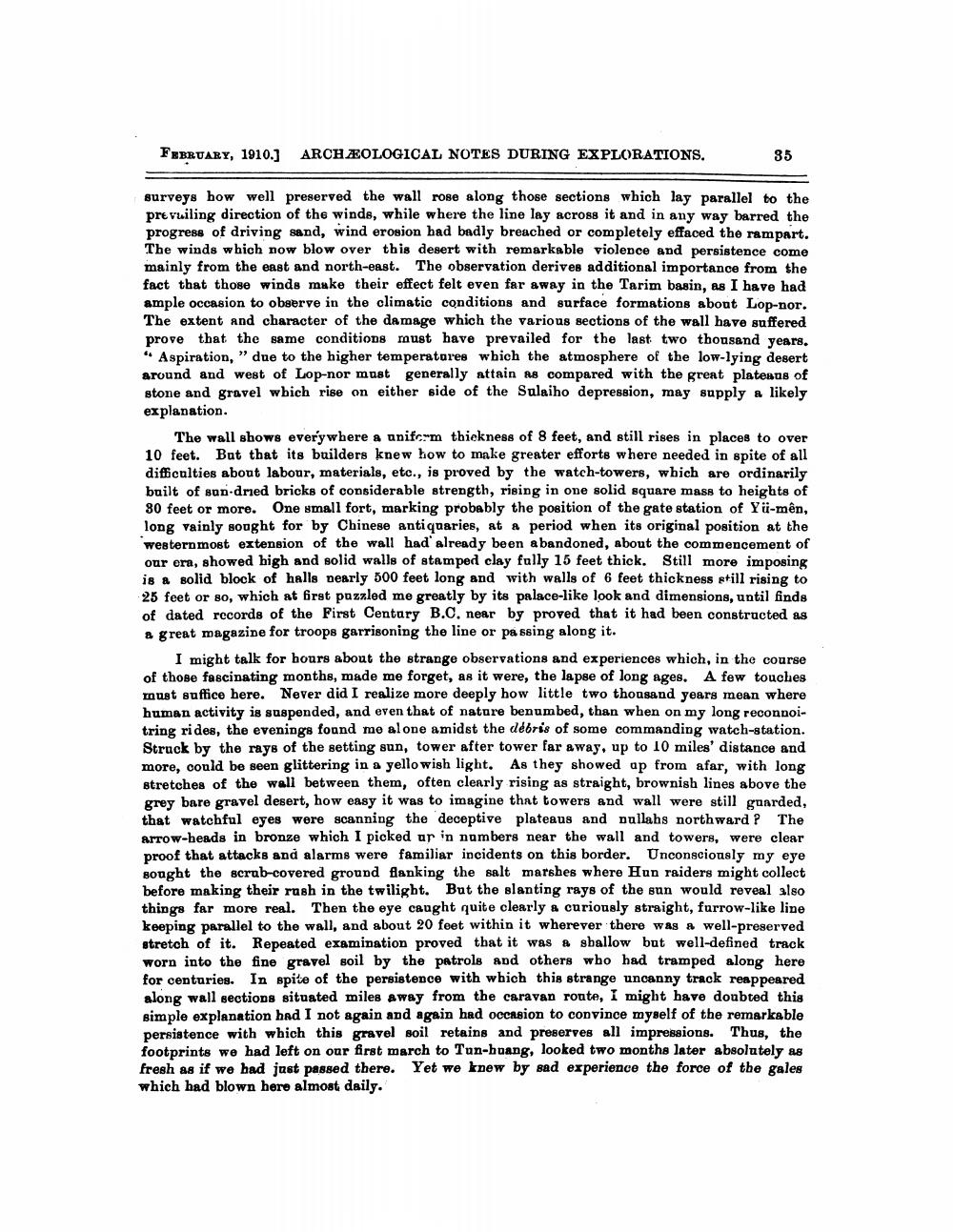________________
FEBRUARY, 1910.] ARCHEOLOGICAL NOTES DURING EXPLORATIONS.
surveys how well preserved the wall rose along those sections which lay parallel to the pre vuiling direction of the winds, while where the line lay across it and in any way barred the progress of driving sand, wind erosion had badly breached or completely effaced the rampart. The winds which now blow over this desert with remarkable violence and persistence come mainly from the east and north-east. The observation derives additional importance from the fact that those winds make their effect felt even far away in the Tarim basin, as I have had ample occasion to observe in the climatic conditions and surface formations about Lop-nor. The extent and character of the damage which the various sections of the wall have suffered prove that the same conditions must have prevailed for the last two thousand years. Aspiration," due to the higher temperatures which the atmosphere of the low-lying desert around and west of Lop-nor must generally attain as compared with the great plateaus of stone and gravel which rise on either side of the Sulaiho depression, may supply a likely explanation.
35
The wall shows everywhere a uniform thickness of 8 feet, and still rises in places to over 10 feet. But that its builders knew how to make greater efforts where needed in spite of all difficulties about labour, materials, etc., is proved by the watch-towers, which are ordinarily built of sun-dried bricks of considerable strength, rising in one solid square mass to heights of 30 feet or more. One small fort, marking probably the position of the gate station of Yü-mên, long vainly sought for by Chinese antiquaries, at a period when its original position at the westernmost extension of the wall had already been abandoned, about the commencement of our era, showed high and solid walls of stamped clay fully 15 feet thick. Still more imposing is a solid block of halls nearly 500 feet long and with walls of 6 feet thickness still rising to 25 feet or so, which at first puzzled me greatly by its palace-like look and dimensions, until finds of dated records of the First Century B.C. near by proved that it had been constructed as a great magazine for troops garrisoning the line or passing along it.
I might talk for hours about the strange observations and experiences which, in the course of those fascinating months, made me forget, as it were, the lapse of long ages. A few touches must suffice here. Never did I realize more deeply how little two thousand years mean where human activity is suspended, and even that of nature benumbed, than when on my long reconnoitring rides, the evenings found me alone amidst the débris of some commanding watch-station. Struck by the rays of the setting sun, tower after tower far away, up to 10 miles' distance and more, could be seen glittering in a yellowish light. As they showed up from afar, with long stretches of the wall between them, often clearly rising as straight, brownish lines above the grey bare gravel desert, how easy it was to imagine that towers and wall were still guarded, that watchful eyes were scanning the deceptive plateaus and nullahs northward? The arrow-heads in bronze which I picked ur in numbers near the wall and towers, were clear proof that attacks and alarms were familiar incidents on this border. Unconsciously my eye sought the scrub-covered ground flanking the salt marshes where Hun raiders might collect before making their rush in the twilight. But the slanting rays of the sun would reveal also things far more real. Then the eye caught quite clearly a curiously straight, furrow-like line keeping parallel to the wall, and about 20 feet within it wherever there was a well-preserved stretch of it. Repeated examination proved that it was a shallow but well-defined track worn into the fine gravel soil by the patrols and others who had tramped along here for centuries. In spite of the persistence with which this strange uncanny track reappeared along wall sections situated miles away from the caravan route, I might have doubted this simple explanation had I not again and again had occasion to convince myself of the remarkable persistence with which this gravel soil retains and preserves all impressions. Thus, the footprints we had left on our first march to Tun-huang, looked two months later absolutely as fresh as if we had just passed there. Yet we knew by sad experience the force of the gales which had blown here almost daily.




